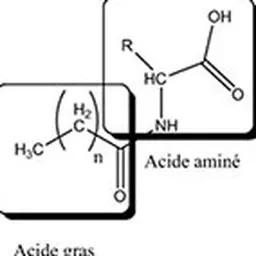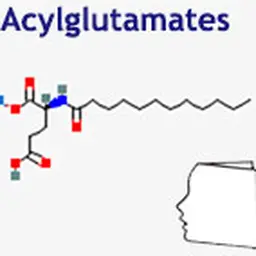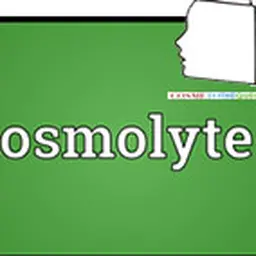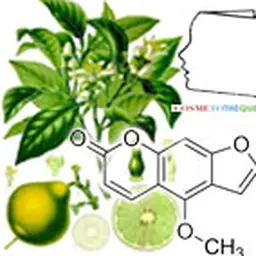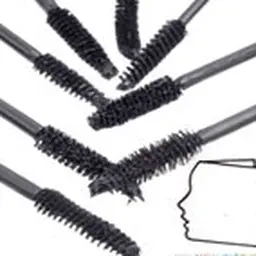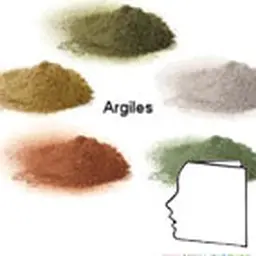
In the lipopeptide saga, we have already described several substances that are very often characterized by their biological properties. But lipopeptides are not only"active" or functionalizing substances. In addition to the famous"acyl glutamates" and other lipoamino acids already mentioned, another substance is widely used in a large number of formulations and/or applications. It is Lauroyl lysine. Considered by many formulators as an exceptional substance, it allows a large number of applications.
This ingredient acts as a powerful texture modifier by improving it, even at low doses. Over the period 2012/2016, there were more than 260 uses in all types of products. Here is a small anthology (source : cosmetikwatch.com ).
Foundation foundation
AQUA/WATER, CYCLOPENTASILOXANE, PROPYLENE GLYCOL, METHYL METHACRYLATE CROSSPOLYMER, DIMETHICONE, ISONONYL ISONONANOATE, SODIUM CHLORIDE, PEG/PPG-18/18 DIMETHICONE, PEG-10 DIMETHICONE, ALUMINUM STARCH OCTENYLSUCCINATE, ZINC PCA, SILICA, ERYTHRITOL, PHENOXYETHANOL, TOCOPHERYL ACETATE, DISTEARDIMONIUM HECTORITE, CHLORPHENESIN, DIMETHICONE CROSSPOLYMER, PERFUME/FRAGRANCE, ALCOHOL DENAT.,
LAUROYL LYSINE
DISODIUM EDTA, ALPHA-ISOMETHYL IONONE, POTASSIUM SORBATE, SODIUM BENZOATE, HOMARIN HCL, AMYL CINNAMAL, GOSSYPIUM HERBACEUM (COTTON) FLOWER EXTRACT, TRIETHOXYCAPRYLYLSILANE, DIMETHICONE/METHICONE COPOLYMER, +/- (MAY CONTAIN) CI 77007 (ULTRAMARINES), CI 77019 (MICA), CI 77288 (CHROMIUM OXIDE GREENS), CI 77491, CI 77492, CI 77499 (IRON OXIDES), CI 77742 (PURPLE MANGANESE).
Cream of care AQUA/WATER, GLYCERIN, OCTYLDODECYL NEOPENTANOATE, HYDROGENATED POLYISOBUTENE, SILICA, C12-15 ALKYL BENZOATE, PENTYLENE GLYCOL, OCTYLDODECANOL, PEG-40 STEARATE, CAMELLIA KISSI SEED OIL, GLYCERYL STEARATE, AMMONIUM ACRYLOYLDIMETHYLTAURATE/VP COPOLYMER, ZINGIBER OFFICINALE (GINGER) ROOT EXTRACT, CAMELLIA JAPONICA FLOWER EXTRACT, BUTYROSPERMUM PARKII (SHEA) BUTTER, PHYTOSTERYL CANOLA GLYCERIDES, PHENOXYETHANOL, SACCHARIDE ISOMERATE, CETYL ALCOHOL, STEARETH-2, DIMETHICONE, PERFUME/FRAGRANCE, CAPRYLYL GLYCOL, SODIUM CARBOMER, LAUROYL LYSINE PROPYLENE GLYCOL, PEG-12, PENTAERYTHRITYL TETRA-DI-T-BUTYL HYDROXYHYDROCINNAMATE, SODIUM HYALURONATE, SODIUM CITRATE, PHYTIC ACID, CITRIC ACID, METHYLPARABEN, TOCOPHEROL, PROPYLPARABEN, ASCORBYL PALMITATE, ETHYLPARABEN, SODIUM BENZOATE.
Blush MICA, TALC, ZINC STEARATE, SILICA, CENTELLA ASIATICA EXTRACT, AQUA/WATER, DIMETHICONE, CAPRYLYL GLYCOL, SYNTHETIC BEESWAX, ETHYLHEXYLGLYCERIN, TRIETHOXYCAPRYLYLSILANE, MAGNESIUM MYRISTATE, CAPRYLIC/CAPRIC TRIGLYCERIDE, HYDROGENATED LECITHIN, METHICONE, LAUROYL LYSINE BUTYLENE GLYCOL, SODIUM DEHYDROACETATE, TOCOPHEROL, PERFUME/FRAGRANCE, HEXYL CINNAMAL, ALPHA-ISOMETHYL IONONE, LINALOOL, EUGENOL, GERANIOL, LIMONENE, CITRONELLOL, CI 73360/RED 30, CI 77492/IRON OXIDES, CI 77007/ULTRAMARINES, CI 77499/IRON OXIDES.
Powder ACTIVE INGREDIENTS: OCTINOXATE- TALC, SYNTHETIC WAX, NYLON-12, PTFE, MAGNESIUM STEARATE, TITANIUM DIOXIDE, MICA, OCTYLDODECYL STEAROYL STEARATE, DIMETHICONE, PENTAERYTHRITYL TETRAISOSTEARATE, LAUROYL LYSINE TOCOPHERYL ACETATE, CAPRYLYL GLYCOL, ALOE BARBADENSIS LEAF JUICE, SQUALANE, POLYQUATERNIUM-61, +/- (MAY CONTAIN)-CI 77019 (MICA), CI 77491 (IRON OXIDES), CI 77891 (TITANIUM DIOXIDE), CI 77492 (IRON OXIDES), IRON OXIDE (CI 77499), CI 77007 (ULTRAMARINES), CI 77742 (MANGANESE VIOLET), CI 77510 (FERRIC FERROCYANIDE), CI 75470 (CARMINE), SYNTHETIC FLUORPHLOGOPITE, ALUMINA, SILICA.
CC Cream from an organic brand ANTHEMIS NOBILIS FLOWER WATER*, AQUA (WATER), DICAPRYLYL ETHER, DICAPRYLYL CARBONATE, COCO-CAPRYLATE/CAPRATE, POLYGLYCERYL-2 DIPOLYHYDROXYSTEARATE, HYDROGENATED BEOR OIL, GLYCERIN, ACACIA DECURRENS/JOJOBA/SUNFLOWER SEED WAX/POLYGLYCERYL-3 ESTERS, BUTYROSPERMUM PARKII (SHEA) BUTTER*, LAUROYL LYSINE POLYGLYCERYL-3 DIISOSTEARATE, ZINC OXIDE, MAGNESIUM SULFATE, SODIUM CHLORIDE, SODIUM LEVULINATE, IRIS GERMANICA ROOT*, PERFUME (FRAGRANCE), PUNICA GRANATUM SEED OIL*, TRIHYDROXYSTEARIN, ALUMINUM HYDROXIDE, SODIUM BENZOATE, BISABOLOL, GLYCERYL CAPRYLATE, GLYCERYL UNDECYLENATE, ALCOHOL, SODIUM LAUROYL GLUTAMATE, SODIUM HYALURONATE, SILICA, LACTIC ACID, LYSINE, MAGNESIUM CHLORIDE, PRUNUS PERSICA (PEACH) LEAF EXTRACT*, TOCOPHEROL, GERANIOL, GINKGO BILOBA LEAF EXTRACT*, CITRONELLOL, PYRUS MALUS (APPLE) FRUIT EXTRACT*, RUBUS IDAEUS (RASPBERRY) FRUIT EXTRACT*, ROSMARINUS OFFICINALIS (ROSEMARY) EXTRACT*, +/- (MAY CONTAIN) CI 77891 (TITANIUM DIOXIDE), CI 77492 (IRON OXIDES), CI 77491 (IRON OXIDES), MICA, CI 77499 (IRON OXIDES). Ingredients from organic farming.
These remarkable properties mean that Lauroyl lysine rarely appears in the first lines of ingredient lists. This is because of its ability to change things, even at low doses. Some formulations are exceptions to this rule like this: AQUA (WATER), SQUALANE, LAUROYL LYSINE GLYCERIN, CAMELLIA SINENSIS LEAF EXTRACT, BUTYROSPERMUM PARKII (SHEA) BUTTER EXTRACT, SODIUM POLYACRYLATE, STEARETH-21, CAPRYLYL GLYCOL, PHENOXYETHANOL.
In addition to texture modifier applications, Lauroyl lysine has good antioxidant properties, as do other basic amino acid derivatives, which would be worth considering a little more for this purpose. This ingredient, developed a few decades ago by the world leader in amino acids, Ajinomoto, was well worth devoting one of the chapters to its characteristics. Especially since it is still an ingredient of choice for its performance, stability and remarkable safety.
Jean Claude Le Joliff
A powdery texture modifier: Lauroyl lysine
Lauroyl lysine (trade name: Amihope LL, referred to as LL in this presentation) is known as a particularly interesting ingredient in the formulation of cosmetic products for make-up, skin care, hygiene products and other such products. The unique properties of LL as a powder texture modifier result from its chemical structure. It is a small organic molecule, resulting from the reaction between lauric acid and an essential amino acid, lysine (see Figure 1 opposite). The lauric fraction of the acid part provides excellent emolliency and adhesiveness, while the lysine part transforms it into an insoluble and stable crystal. To produce insoluble fatty acids, metals such as zinc or calcium have long been used. In the case of LL, the idea was to use a dibasic amino acid. Fatty acid and amino acid are covalently bound, resulting in high chemical stability. Moreover, this product gives a great softness to the skin.
This type of structure is often referred to as amino acid acyl and many such compounds are rather known as surfactants(1). In fact, LL was first prepared with the objective of creating a new group of amphoteric surfactants, but the product was found to be hardly soluble in water or any kind of cosmetic solvents (see Table 1), making its use virtually impossible(2). After many tests to make Lauroyl lysine soluble(3), a researcher succeeded in recrystallizing it to obtain elliptical particles with a particularly silky and extremely smooth touch. This ultimately led to the product being marketed as a powdered texture-enhancing ingredient rather than a surfactant.
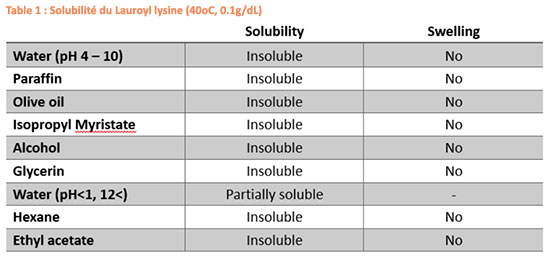
In addition to its exceptional lubricity, LL has another remarkable property that makes it a particularly suitable ingredient for make-up formulation: the low value of its refractive index compared to other cosmetic ingredients leads to a very natural effect on the skin. The refractive index of several cosmetic ingredients is described in Table 2 below.

The use of this ingredient in powder coloured cosmetics (make-up) also provides many advantages. For example: how to improve make-up hold and dry skin characters? These are the challenges of developing a foundation or loose powder, when a formulator can only incorporate a small dose of emollients into the product. LL then functions as a"powder emollient" in this application.
In Figure 4 opposite, 5 to 20% LL has been added in a conventional free powder formula comparable to those on the market. The results of the sensory evaluation show that in addition to 5%, LL improves application and adhesion during application and contributes to a strong decrease in the dry effect upon application. Almost all panelists noted an improvement with an addition at the 10% rate and the 20% supplement further improving adhesion, application and coverage, and a strong improvement in dryness sensation.
By treating pigments or powder fillers, LL delivers a soft feel and significantly reduces dry skin caused by pigments. LL also confers hydrophobicity to powders, resulting in improved pigment dispersion and better make-up hold.
In skin care products such as creams or lotions, the incorporation of this emollient generates even more remarkable associated benefits. The addition of LL develops a rich and smooth touch, without sticky or greasy effect. How to reduce being fat was the challenge. This cream has been developed as a classic night cream, rather high level emollient oils but no silicone has been incorporated. By adding 0.3% LL, excellent absorption through the skin was achieved without sacrificing a lasting moisturizing sensation. This is especially useful in applications such as body lotion or hand cream, as no one wants greasy hands.

The LL also adds many advantages to the surfactants in the cleansing formulations: a"pearlescence" effect(7) (pearlescent effect), as well as improved wet styling. T However, because of the high hydrophobicity of this ingredient, it requires that the formulas incorporating LL in the surfactant be adapted(6). It is much easier to add LL in a thick cream or in a type of cleansing gel formulation. Figure 6 shows the result of the heavy duty conditioner test with 0.5% LL. The capillary fibres have been well aligned, but do not overlap and the volume to the root has been well maintained.
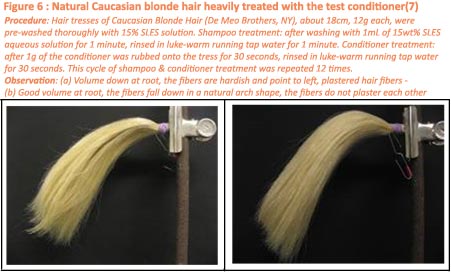
Conclusions
Lauryl lysine is obtained from a natural fatty acid and an essential amino acid, lysine. It is a unique powdery ingredient that adds many benefits in diverse applications. In a powdery base formulation, it works as a powder emollient to improve adherence to the skin and reduce the drying effects of mineral powders. In rich emulsions, it works as an emollient, reducing greasy feeling without sacrificing hydration. The scope of application extends into the formulations of rinsing products.
References (1). Xia J., Nnanna, I. A., Sakamoto, K., 2001. Amino Acid Surfactants: Chemistry, Synthesis, and Properties. In Jiding Xia (Ed.), Protein-Based Surfactants: Synthesis: Physicochemical Properties, and Applications, Surfactant Science Series Vol. 101 1st Edition, (Chapter 4, pp. 75-122) New York, USA: Marcel Dekker Inc. (2) Sagawa, K., Takehara, M., 1987. New cosmetic powder derived from amino acid - properties of Amihope LL and its cosmetic uses -. Funntai-to-Kogyo. 19, 1-7. (3) Yokota, H., Sagawa, K., Eguchi, C., Takehara, M., 1985. New amphoteric surfactants derived from lysine. I. Preparation and properties of Ne-acyllysine derivatives. J. Bitter. Oil Chem., Soc. 62, 1716-1719. (4) AJINOMOTO Co., Inc. not published (5) AJINOMOTO Co., Inc. not published (6) AJINOMOTO Co., Inc. not published (7) Gesslein B. W., Oshimura, E., Popova, K., 2014. Water Dispersible Lauroyl Lysine in Cleansing Applications. SÖFW-J. 140, 30-35.
| Contribution made by Eiko Oshimura Dr. JEiko Oshimura is Director in the Personal Care Group at AJINOMOTO, Inc. and supports customers in developing products with knowledge, experience in chemistry and amino acid application based on 23 years of service as a cosmetic chemist in the laboratory. |
| About AJINOMOTO Co., Inc. Ajinomoto is one of the world's leading manufacturers of amino acids. This company found its inspiration in the 1970s by studying the excellent compatibility of amino acids with the human body and environment, since exploring the potential of amino acids and their derivatives for use in cosmetic care products, among others. |

